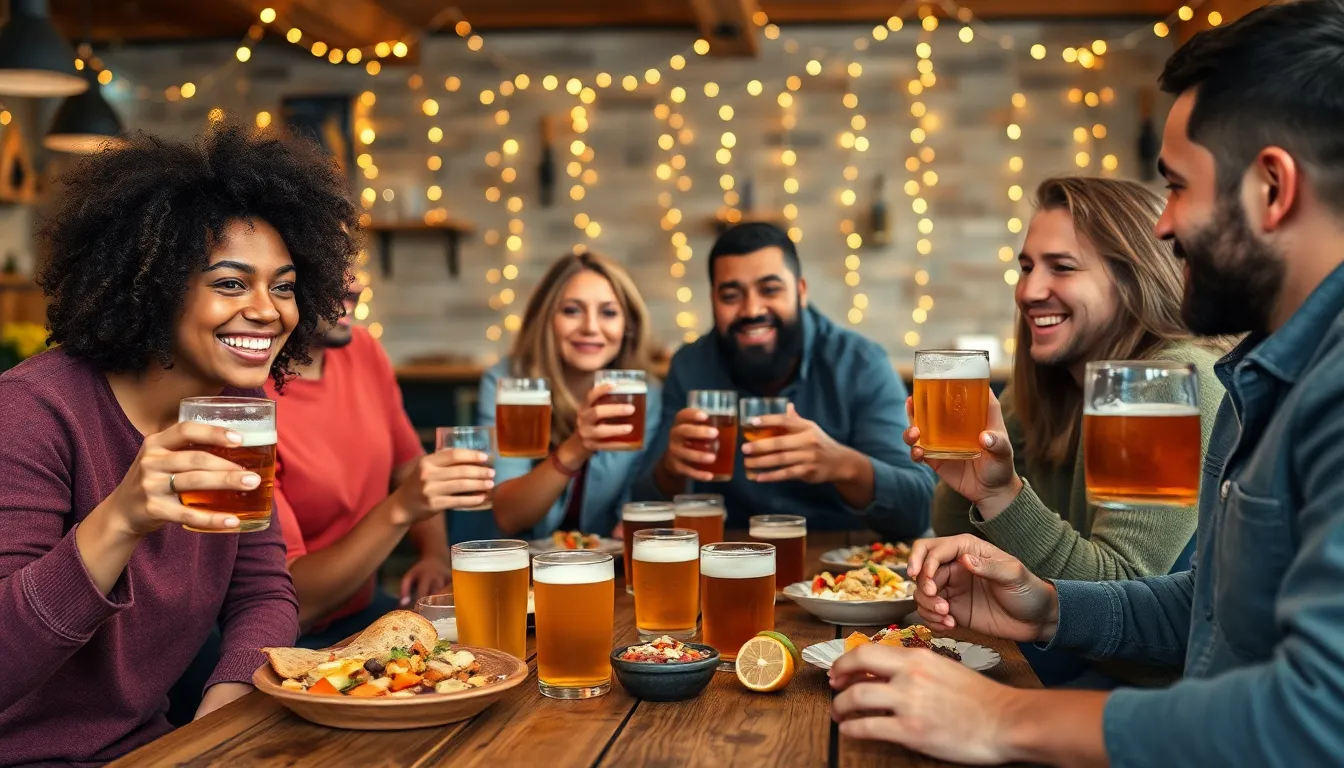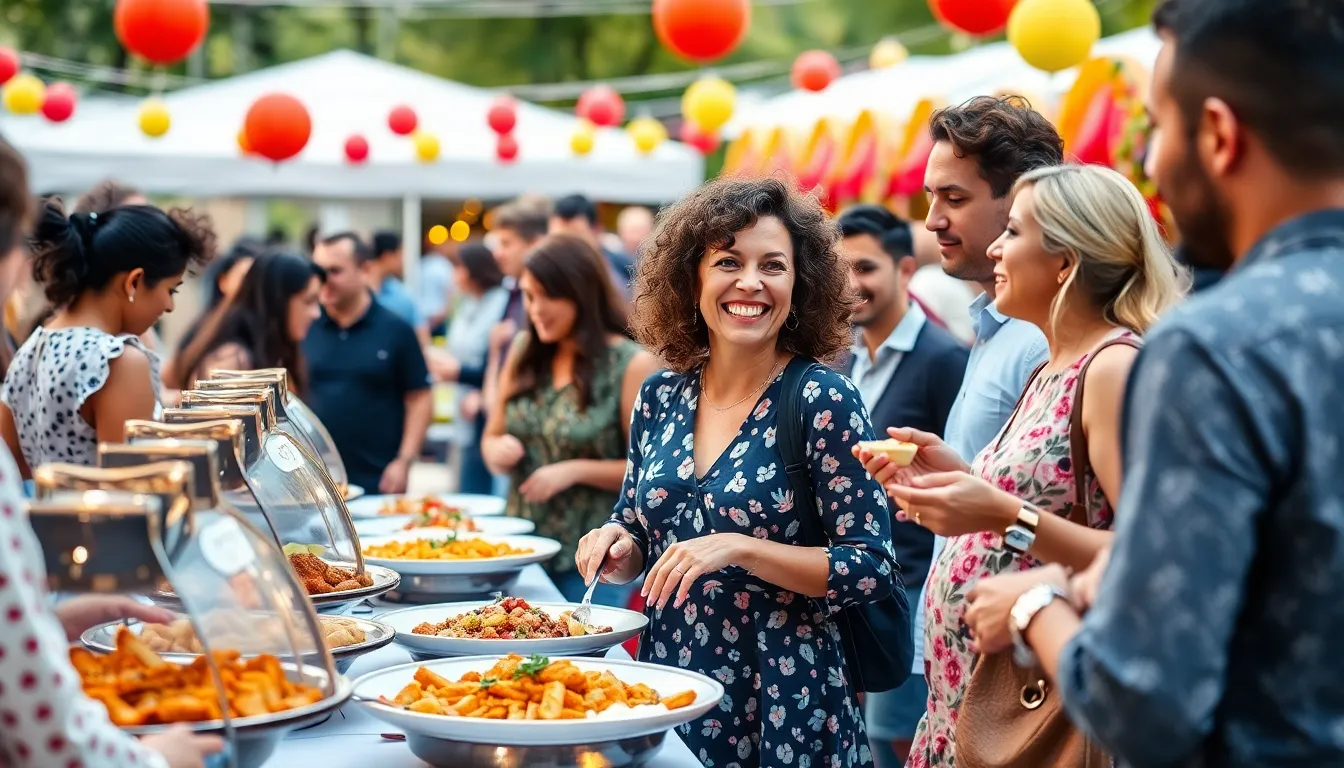Food tasting events have become a delightful way for culinary enthusiasts to explore diverse flavors and discover new favorites. These gatherings not only showcase local chefs and artisans but also create a vibrant community atmosphere where food lovers can connect and share their experiences. From gourmet festivals to intimate wine and cheese pairings, there’s an event for every palate.
As people increasingly seek unique dining experiences, food tasting events offer an exciting opportunity to sample a variety of dishes in one setting. Attendees can indulge in everything from exotic spices to decadent desserts, making each event a feast for the senses. Whether you’re a seasoned foodie or just looking to expand your culinary horizons, these events promise unforgettable moments and delicious discoveries.
Table of Contents
ToggleOverview of Food Tasting Events
Food tasting events offer culinary enthusiasts opportunities to discover diverse flavors and engage with local chefs and artisans. These gatherings occur in various formats, including gourmet festivals, wine and food pairings, and pop-up tasting dinners. Participants sample multiple dishes or beverages, enhancing their appreciation for culinary arts.
Event types include:
- Gourmet festivals: Large gatherings featuring numerous vendors and a wide array of cuisines, attracting food lovers with diverse tastes.
- Intimate pairings: Smaller events focused on specific themes, such as wine pairings with meticulously crafted dishes, fostering deeper connections among attendees.
- Culinary tours: Events where participants explore local eateries while sampling signature dishes and learning about the culinary landscape.
As food tasting events grow, they create vibrant community atmospheres. Attendees share experiences and interact with chefs, enhancing social connections and fostering relationships between consumers and producers. These occasions cater to seasoned foodies and newcomers eager to expand their culinary horizons.
Types of Food Tasting Events

Food tasting events encompass various themes and styles, catering to diverse culinary interests. Below are some popular types of food tasting events.
Wine and Cheese Tastings
Wine and cheese tastings offer attendees the chance to explore the synergy between different wine varietals and cheese pairings. At these events, guests sample multiple wines alongside an array of cheeses, often guided by experts who provide insights into the flavor profiles and best combinations. Popular formats include structured tastings, where each pairing is presented sequentially, or casual mingling sessions that encourage attendees to experiment with their pairings. Events may also feature local wines and artisanal cheeses, highlighting regional artisans and enhancing the tasting experience.
Craft Beer Tastings
Craft beer tastings emphasize the rich diversity of beer styles produced by small breweries. Participants usually sample a selection of beers, often including IPAs, stouts, and ales, while learning about brewing techniques and flavor notes. These events may also incorporate food pairings, where local chefs create dishes specifically designed to complement the selected beers. Some tastings provide attendees with insights into the brewing process, featuring talks from brewmasters, while others may include competitions or collaborations between various craft brewers, making them both educational and entertaining.
Cultural Food Festivals
Cultural food festivals celebrate the culinary traditions of specific regions or communities. These events showcase a variety of traditional dishes, often prepared by local chefs and home cooks, allowing attendees to experience authentic flavors from around the world. Guests sample everything from street food to gourmet offerings, immersing themselves in the cultural heritage associated with each dish. Cultural performances, cooking demonstrations, and workshops frequently accompany these festivals, creating a comprehensive experience that highlights the connection between food, culture, and community.
Benefits of Attending Food Tasting Events
Food tasting events offer numerous advantages, enriching the culinary landscape for attendees. Participants enjoy unique experiences and discover new flavors, all while connecting with fellow enthusiasts.
Exploring New Flavors
Exploring new flavors stands as a primary benefit of attending food tasting events. Attendees sample diverse dishes from various cuisines, expanding their palate and inspiring culinary creativity. Events often feature unique ingredients or innovative pairings that challenge traditional tastes. Participating in these gatherings fosters an appreciation for local ingredients and artisanal methods. For instance, a cheese and wine tasting may reveal unexpected pairings, enhancing the overall tasting experience.
Social Networking Opportunities
Social networking opportunities abound at food tasting events. Attendees connect with chefs, artisans, and other food lovers, promoting a sense of community. Interaction with industry professionals can lead to valuable insights, culinary collaborations, or even future dining experiences. Engaging with like-minded individuals often results in lasting friendships rooted in a shared passion for food. Networking at these events enables participants to exchange recommendations and discover hidden gems within their local culinary scenes.
Tips for Organizing a Food Tasting Event
Organizing a successful food tasting event requires careful planning and attention to detail. Key factors to consider include selecting the right venue and curating a diverse menu that captivates attendees.
Selecting the Right Venue
Choosing an appropriate venue significantly impacts the event’s success. Consider the following points:
- Capacity: Ensure the venue accommodates the expected number of attendees comfortably.
- Location: Pick a central location for easy accessibility, ideally near public transportation and parking options.
- Ambiance: Select a space that aligns with the event’s theme, enhancing the overall experience for guests.
- Facilities: Verify that the venue has necessary amenities, such as adequate kitchen space, restrooms, and seating arrangements.
- Flexibility: Opt for a venue that allows customization and can adapt to changing requirements during the event.
Curating the Menu
An engaging menu creates memorable experiences. Focus on these aspects:
- Diversity: Include a variety of dishes representing different cuisines, dietary restrictions, and flavor profiles.
- Seasonality: Prioritize seasonal ingredients for fresher, more vibrant flavors that resonate with attendees.
- Pairings: Consider complementary pairings, such as wine with cheese or craft beer with specific dishes, to enhance tasting experiences.
- Sampling Sizes: Offer small portions to allow guests to try multiple dishes without feeling overwhelmed.
- Interactive Options: Incorporate stations or demonstrations, enabling guests to engage with chefs and learn about preparation techniques.
Focusing on venue selection and menu curation creates a cohesive food tasting event that delights attendees and fosters connections within the culinary community.
Food tasting events have become a dynamic way for culinary enthusiasts to engage with flavors and connect with others who share their passion. These gatherings not only introduce attendees to a variety of dishes but also create a sense of community around food.
As the popularity of these events continues to rise, they offer exciting opportunities for exploration and connection. Whether it’s experiencing gourmet delights or participating in intimate pairings, food tasting events enrich the culinary landscape.
Ultimately, these occasions celebrate the art of food and foster relationships among chefs, artisans, and food lovers alike. Embracing these experiences can lead to unforgettable memories and a deeper appreciation for the diverse world of cuisine.





